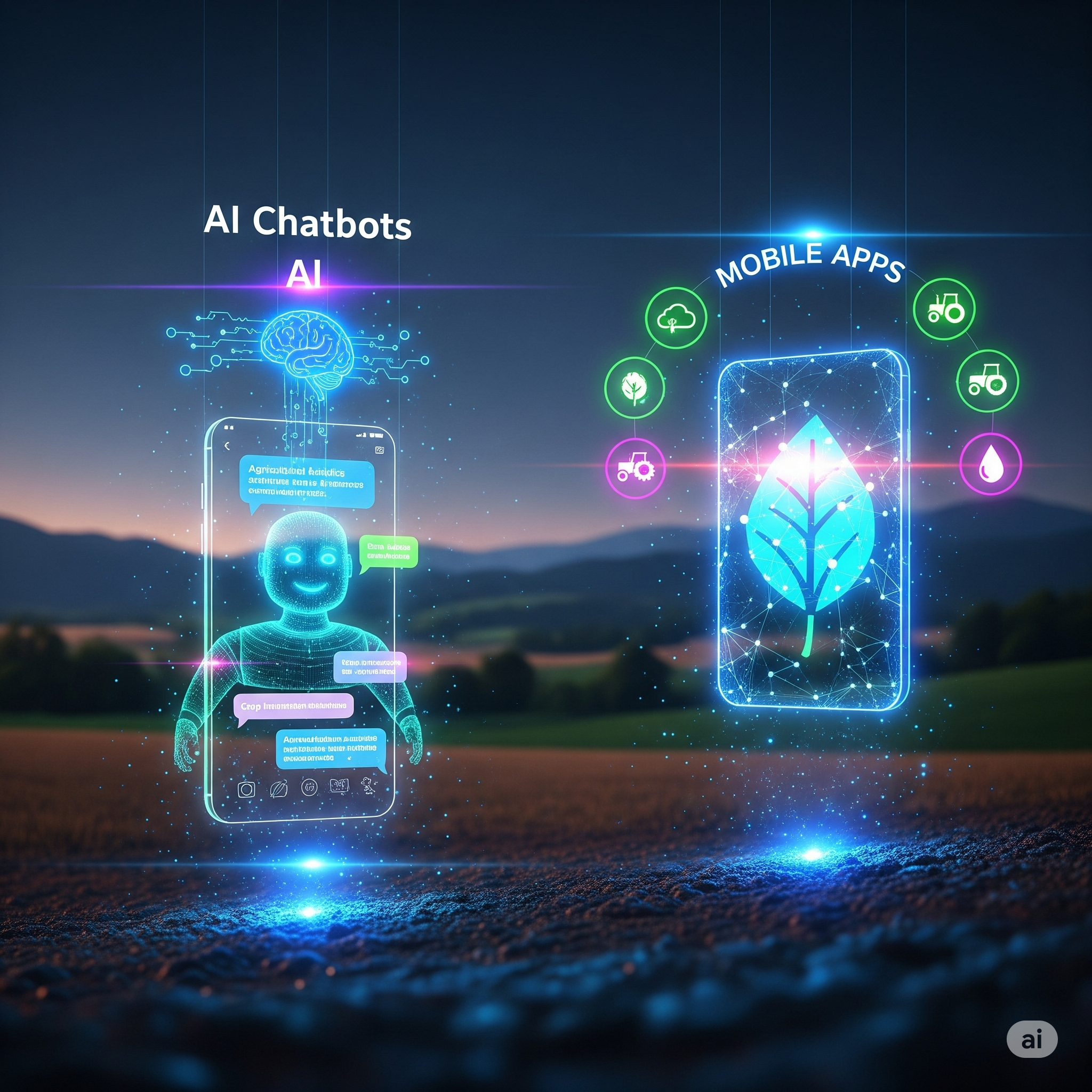🌾 Introduction
Agriculture in India is undergoing a remarkable digital transformation. As the sector strives to address long-standing challenges such as information asymmetry, low productivity, climate unpredictability, and limited extension services, technology is emerging as a game-changer. Among the most impactful innovations are AI-based chatbots and mobile applications, which are revolutionizing how farmers receive timely and relevant advice.
From sowing to harvesting and selling crops, these digital tools offer personalized support to millions of smallholder farmers, especially in remote and underserved areas. In this article, we delve into the role, benefits, challenges, and future potential of AI chatbots and mobile apps in farmer advisory services.
🤖 What Are AI Chatbots and Mobile Apps in Agriculture?
AI Chatbots:
AI chatbots are automated programs that simulate human-like conversations with users through messaging platforms. In agriculture, they are trained using agronomic data, weather patterns, local languages, and crop-specific knowledge to provide farmers with real-time advice.
Mobile Applications:
Agri-mobile apps are smartphone applications designed to assist farmers with services such as crop selection, market pricing, weather forecasts, pest diagnosis, and even loan and insurance services. These apps often integrate chatbot features for an interactive experience.
Examples include:
- Kisan Suvidha
- Plantix
- AgriApp
- BharatAgri
- RML AgTech
- Fasal
- Gramophone
🚜 Why Farmer Advisory Services Are Crucial
Traditional farmer advisory services, often provided by government extension officers or Krishi Vigyan Kendras (KVKs), have struggled to meet the scale and diversity of India’s farming needs. Key limitations include:
- Limited reach and staff
- Generic advice lacking local relevance
- Delays in response time
- Communication gaps due to language or literacy barriers
Digital solutions bridge these gaps by:
- Offering localized, real-time support
- Operating 24/7, even in remote areas
- Providing information in vernacular languages
- Collecting data for personalized advice
💡 Key Functions of AI Chatbots and Mobile Apps in Agriculture
1. Weather Forecast and Alerts
- Real-time weather updates and alerts (rainfall, heatwaves, frost, etc.)
- Helps in planning irrigation, pesticide application, and harvesting
2. Crop and Soil Advisory
- Best sowing time based on soil health and weather
- Fertilizer application schedules
- Soil testing data integration
3. Pest and Disease Diagnosis
- Upload pictures to get instant diagnosis via AI-powered image recognition
- Suggests organic or chemical treatment solutions
4. Market and Price Information
- Daily mandi prices
- Trends and demand forecasts
- Nearby market connectivity options
5. Government Schemes and Subsidy Updates
- Information on PM-KISAN, crop insurance, seed subsidies, etc.
- Application support and status tracking
6. Financial Services
- Access to micro-credit, crop loans, and insurance
- Digital KYC and onboarding
7. Farmer Community Forums
- Peer-to-peer learning
- Sharing experiences and best practices
8. Multilingual Voice-Based Interfaces
- Vital for low-literacy farmers
- Voice assistants using regional dialects
📱 Case Studies of Impact
📍 Example 1: Plantix (AI Pest Diagnosis App)
- Used by over 10 million farmers globally
- Farmers upload crop images, and AI diagnoses pests/diseases with over 92% accuracy
- Personalized treatment plans are suggested
📍 Example 2: BharatAgri (AI-based Agri Advisor)
- Provides personalized crop calendars based on farm data
- Reported 20–40% increase in yield for subscribed farmers
📍 Example 3: RML AgTech
- Offers multi-lingual market insights, weather alerts, and crop advisory
- Serves over 5 million users
📈 Benefits of AI Chatbots and Agri Apps
| Benefit | Impact on Farmers |
|---|---|
| 24/7 Availability | Farmers can get advice anytime without waiting for an extension officer |
| Cost-effective | Freemium models make advisory affordable or free |
| Personalized Insights | Data-driven recommendations based on individual farm profiles |
| Multilingual Access | Local dialect support ensures wider reach |
| Instant Communication | Reduces delay in decision-making |
| Scalable | One chatbot can assist thousands of farmers simultaneously |
⚙️ Technologies Behind the Scenes
AI & ML:
Used to train chatbots to interpret farmer queries and provide contextually relevant answers.
Natural Language Processing (NLP):
Helps understand regional languages and dialects.
Image Recognition:
Used in diagnosing crop diseases, pest infestations via photos.
Cloud Computing:
Supports real-time data access and storage.
GPS & GIS:
Provides location-based advisory and tracking services.
🎯 Government and Institutional Support
The Indian government and organizations are actively supporting tech-driven farmer advisory systems:
- Digital Agriculture Mission (2021–25)
- eNAM integration with mobile platforms
- ICAR partnerships with startups
- State-run apps like Kisan Suvidha and Pusa Krishi
🧱 Challenges and Limitations
1. Digital Literacy and Smartphone Access
- Only ~40% of rural households have smartphones
- Many farmers are unaware of how to use apps
2. Language and Cultural Barriers
- India has over 20+ regional languages
- NLP must be trained extensively to cater to diversity
3. Internet Connectivity Issues
- Rural India still struggles with stable internet
4. Trust and Tech Skepticism
- Farmers may doubt the credibility of app-generated advice
5. Data Privacy Concerns
- Handling of sensitive farmer data needs robust governance
🛣️ Future Potential
AI and mobile-based advisory systems are just beginning to show their potential. With improvements in connectivity, data integration, and machine learning, the next decade could witness a complete transformation of Indian agriculture.
🌟 Key Trends to Watch:
- Voice-first chatbots in all regional languages
- Predictive analytics for pest and weather forecasting
- Integration with IoT sensors for soil and crop monitoring
- Hyper-local advisory based on satellite and drone data
- Blockchain for transparent subsidy distribution and produce traceability
🎓 Educational and Research Implications
For agriculture students and researchers:
- Study human-computer interaction in rural settings
- Design AI tools that are inclusive and intuitive
- Research localized language models for better NLP performance
- Evaluate impact metrics on yield, income, and adoption rate
✅ Conclusion
AI chatbots and mobile apps are redefining farmer advisory services in India, making them faster, smarter, and more accessible than ever before. As these technologies evolve, they hold the promise of closing the information gap that has long plagued Indian agriculture.
By combining digital innovation with grassroots understanding, India can empower its 120 million+ farmers with the tools and knowledge to grow more, earn more, and thrive sustainably.




